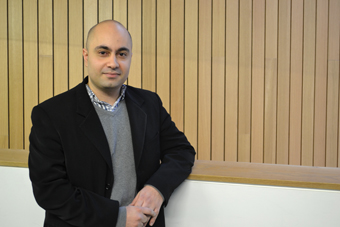New insight into acute inpatient psychiatric care
By Liz Lockhart
Some very interesting information has come to light following a study which has been conducted and published by Dr. Chris Papadopoulos (pictured) of the University of Bedfordshire (Institute for Health Research).  The study, a brainchild of Professor Len Bowers who leads a research programme into conflict and containment within acute psychiatric wards at the Institute of Psychiatry (Kings College London), suggests that it is the ward staff, and not the patients, who play the key role in influencing how much conflict and containment occur on psychiatric wards.
The study, a brainchild of Professor Len Bowers who leads a research programme into conflict and containment within acute psychiatric wards at the Institute of Psychiatry (Kings College London), suggests that it is the ward staff, and not the patients, who play the key role in influencing how much conflict and containment occur on psychiatric wards.
Conflict events include violence, verbal abuse, rule breaking, use of alcohol or illegal drugs, self-harm, medication refusal and absconding by patients. Containment events are what staff do to deal with the conflict event, such as giving medication, secluding a patient, or manually restraining them.
Dr. Papadopoulos explained to Mental Healthy that the study was conducted in two stages. The first stage involved collecting two types of types of data simultaneously on 16 acute psychiatric inpatient wards over a two year period. This quantitative-type data counted and recorded conflict and containment events in each shift over the two year period. As there are three shift each day this amounted to a great deal of data. Qualitative-type data was also collected on these same 16 wards, This data was collected by conducting semi-structured interviews with the staff who worked on the wards. The staff were encouraged to discuss what specific events and happenings had occurred on their ward during the past month.
The information that was given was dated and cross-referenced with case notes so that the researchers knew exactly when a particular event or happening, which had been talked about in interview, had occurred. This qualitative-type data was also collected for two years on a monthly basis.
The second stage was the analysis of this data. For the quantitative data, the researchers produced one (smoothed) line graph for conflict events and one (smoothed) line graph for containment events per ward. This equated to 32 different lines graphs. Dr. Papadopoulos says that these line graphs were really useful because you could visually see how conflict and containment went up and down across the two year period for each ward. In all of these graphs, you could see particular ‘spikes’ or ‘drops in conflict and containment rates, whereby there was a clear, sudden increase or decrease in rates. Dr. Papadopoulos tells us that they called these ‘transitions’. These differed from slow, gradual ups and down-turns.
Next the researchers analysed the qualitative data and this resulted in a variety of different staff-centred themes, patient-centred themes, ward/practice-centred and miscellaneous themes. Examples of staff-centred themes are conflict between staff members and negative staff morale. Patient-centred themes include situations such as an increase in ‘difficult’ patients and patient death and ward/practice-centred themes include things such as environmental improvements which had been made and audit occurring on a ward.
Dr. Papadopoulos explains that the crucial step came next – ‘because our qualitative and quantitative data were both dated and collected during the same period, for 28% of all transitions, we were able to chronologically match the events which happened on a particular ward (collected via the qualitative interviews) with the quantitative conflict and containment data. This helped us to establish what kinds of events caused the transitions on the line graphs to occur.’
Statistical analyses showed that thirteen different themes (from a maximum of 40 qualitative themes) significantly associated with the line graphs transitions, 11 of which belonged to the ‘staff-centred’ themes category - none of which belonged to the patient-centred themes.
‘This basically means that it is the ward staff, and not the patients, who play the key role in influencing how much conflict and containment occurs on psychiatric wards,’ says Dr. Papadopoulos. ‘As wards which have high levels of conflict and containment have been proven to be clinically and (massively) economically costly, this is a very important finding.’
Dr. Papadopoulos told Mental Healthy ‘This is especially interesting as it goes against the stereotyped beliefs that increases in ‘difficult’ patents makes wards more unsafe and less therapeutic places. It is also the first time that data analysis of this sort has been made. Our methods enabled us to provide evidence of cause and effect which is usually very difficult to ascertain and stops you from being able to conclude that one factor is responsible for another.’
‘As such these findings have major implications for inpatient psychiatric care and we’re hopeful that our research can help to improve the patient experience. We have presented our research findings to some of the health trusts which worked with us during the study. Some clinicians have already been in touch to say that what we have discovered means that conflict and containment events are controllable.’





